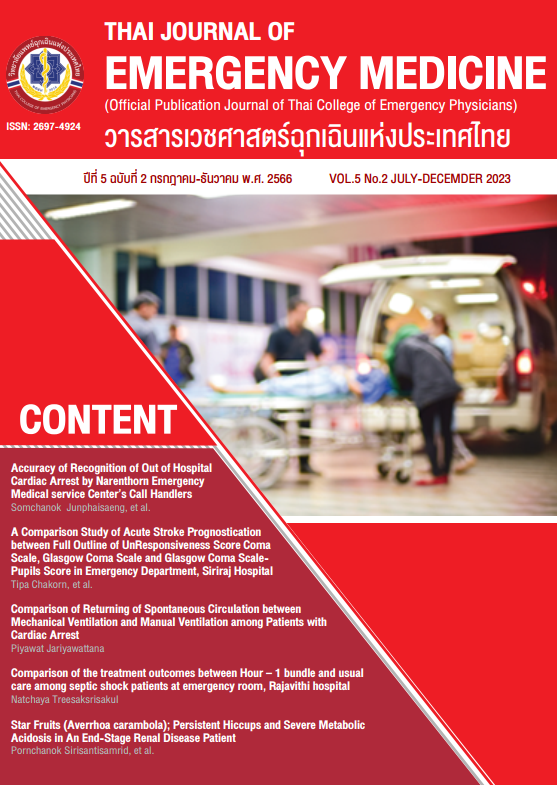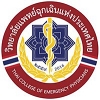Comparison of Returning of Spontaneous Circulation between Mechanical Ventilation and Manual Ventilation among Patients with Cardiac Arrest
Keywords:
cardiopulmonary resuscitation (CPR), mechanical ventilation, manual ventilationAbstract
Backgrounds During the coronavirus outbreak situation, cardiopulmonary resuscitation (CPR) has the potential to cause the spread of the coronavirus from the distribution of droplets, secretions from the mouth and nose of the patient. We recommended to reduce the diffusion of aerosols, secretions from the mouth and nose of patients by using a mechanical ventilator after intubation instead of manual ventilation.
Objectives This research aimed to determine the difference in resuscitation outcomes, vital signs, and post-resuscitation laboratory results in cardiac arrest patients receiving mechanical ventilation compared to those receiving manual ventilation.
Methods The study period was from 2019-2022. We studied 106 patients who were ventilated by mechanical ventilation during the coronavirus outbreak (ventilator setup FiO 2 1.0, respiratory rate 10 bpm, low tidal volume) compared to a group of 96 patients receiving manual ventilation.
Results The researchers conducted an analysis by dividing patients into two groups : cardiac arrest patients who were ventilated by mechanical ventilation and those who were ventilated by manual ventilation. We found that the median CPR duration (30.00±10.812 minute, 30.00±11.600 minute, P value 0.458), systolic blood pressure (0.00±52.867 mmHg, 0.00±57.780 mmHg, P value 0.332), diastolic blood pressure (0.00±30.981mmHg, 0.00±36.219mmHg, P value 0.293), heart rate (0.00±56.079 beat/minute, 0.00±54.772 beat/ minute, P value 0.806), O 2 saturation (0.00±46.941%, 0.00±54.772%, P value 0.806) were no statistical significant difference, and venous blood gas results PvO 2 (34.00±60.29mmHg, 23.00±16.971mmHg, P value 0.319), PvCO 2 (7.810±3.272mmHg, 4.930±9.617mmHg, P value 0.076), lactate (6.760±5.738mmol/L, 5.095±0.784mmol/L, P value 0.884) were no statistical significant difference. But the researchers found that venous blood gas pH (6.914±0.231, 7.210±0.069, P value 0.047) were statistical significant different. There was no difference in the results of resuscitation including return of spontaneous circulation (ROSC) odds ratio(OR) 1.262(95%CI 0.709-2.247, P value = 0.429) and use of blood pressure stimulating drugs OR 0.870(95%CI 0.456- 1.660, P value = 0.672).
Conclusions Return of spontaneous circulation, there was no difference between patients receiving mechanical ventilation and manual ventilation.
References
Couper, K., Taylor-Phillips, S., Grove, A., Freeman, K., Osokogu, O., Court, R., Mehrabian, A., Morley, P. T., Nolan, J. P., Soar, J., & Perkins, G. D. (2020). Covid-19 in cardiac arrest and infection risk to rescuers: A systematic review. Resuscitation, 151, 59–66. https://doi.org/10.1016/j.resuscitation.2020.04.022
Tran, K., Cimon, K., Severn, M., PessoaSilva, C. L., & Conly, J. (2012). Aerosol generating procedures and risk of transmission of acute respiratory infections to healthcare workers: A systematic review. PLoS ONE, 7(4). https://doi.org/10.1371/journal.pone.0035797
Pippin, D. J., Verderame, R. A., & Weber, K. K. (1987). Efficacy of face masks in preventing inhalation of airborne contaminants. Journal of Oral and Maxillofacial Surgery, 45(4), 319–323. https://doi.org/10.1016/0278-2391(87)90352-1
Noti, J. D., Lindsley, W. G., Blachere, F. M., Cao, G., Kashon, M. L., Thewlis, R. E., McMillen, C. M., King, W. P., Szalajda, J. V., & Beezhold, D. H. (2012). Detection of infectious influenza virus in cough aerosols generated in a simulated patient examination room. Clinical Infectious Diseases, 54(11), 1569–1577. https://doi.org/10.1093/cid/cis237
Milton, D. K., Fabian, M. P., Angel, M., Perez, D. R., & McDevitt, J. (2010). Influenza virus aerosols in human exhaled breath: Particle size, culturability, and effect of surgical masks. D25. COMMUNITY ACQUIRED PNEUMONIA : CONTROVERSIES IN MANAGEMENT. https://doi.org/10.1164/ajrccm-conference.2010.181.1_meetingabstracts.a6844
Interim guidance for healthcare providers during COVID-19 outbreak. (n.d.). https://cpr.heart.org/-/media/cpr-files/resources/covid-19-resources-for-cpr-training/interim-guidance-march-19-2020.pdf?la=en&hash=5A491D18BB-B61795442A98A49A50C05173C77EF6
Kill, C., Hahn, O., Dietz, F., Neuhaus, C., Schwarz, S., Mahling, R., Wallot, P., Jerrentrup, A., Steinfeldt, T., Wulf, H., & Dersch, W. (2014). Mechanical ventilation during cardiopulmonary resuscitation with intermittent positivepressure ventilation, bilevel ventilation, or chest compression synchronized ventilation in a pig model*. Critical Care Medicine, 42(2). https://doi.org/10.1097/ccm.0b013e3182a-63fa0
Jamshed, N., Sahu, A. K., Timilsina, G., & Mathew, R. (2020). “six-dial strategy”— mechanical ventilation during cardiopulmonary resuscitation. Indian Journal of Critical Care Medicine, 24(6), 487–489. https://doi.org/10.5005/jp-journals-10071-23464
Ahn, H. J., Kim, K. D., Jeong, W. J., Lee, J. W., Yoo, I. S., & Ryu, S. (2015). The adequacy of a conventional mechanical ventilator as a ventilation method during cardiopulmonary resuscitation: A manikin study. The Korean Journal of Critical Care Medicine, 30(2), 89–94. https://doi.org/10.4266/kjccm.2015.30.2.89
Liu, Y., Qi, Y., Zhang, H., Walline, J., & Zhu, H. (2019). A survey of ventilation strategies during cardiopulmonary resuscitation. World Journal of Emergency Medicine, 10(4), 222. https://doi.org/10.5847/wjem.j.1920-8642.2019.04.005
Tan, D., Xu, J., Shao, S., Fu, Y., Sun, F., Zhang, Y., Hu, Y., Walline, J., Zhu, H., & Yu, X. (2017). Comparison of different inspiratory triggering settings in automated ventilators during cardiopulmonary resuscitation in a porcine model. PLOS ONE, 12(2). https://doi.org/10.1371/journal.pone.0171869
Cordioli, R. L., Lyazidi, A., Rey, N., Granier, J.-M., Savary, D., Brochard, L., & Richard, J.-C. M. (2016). Impact of ventilation strategies during chest compression. an experimental study with Clinical Observations. Journal of Applied Physiology, 120(2), 196–203. https://doi.org/10.1152/japplphysiol.00632.2015
Orso, D., Vetrugno, L., Federici, N., Borselli, M., Spadaro, S., Cammarota, G., & Bove, T. (2020). Mechanical ventilation management during mechanical chest compressions. Respiratory Care, 66(2), 334–346. https://doi.org/10.4187/respcare.07775
Neth, M. R., Idris, A., McMullan, J., Benoit, J. L., & Daya, M. R. (2020). A review of ventilation in adult out-of-hospital cardiac arrest. Journal of the American College of Emergency Physicians Open, 1(3), 190–201. https://doi.org/10.1002/emp2.12065
Orlob, S., Wittig, J., Hobisch, C., Auinger, D., Honnef, G., Fellinger, T., Ristl, R., Schindler, O., Metnitz, P., Feigl, G., & Prause, G. (2021). Reliability of mechanical ventilation during continuous chest compressions: A crossover study of Transport Ventilators in a human cadaver model of CPR. Scandinavian Journal of Trauma, Resuscitation and Emergency Medicine, 29(1). https://doi.org/10.1186/s13049-021-00921-2
Tangpaisarn, T., Tosibphanom, J., Sata, R., Kotruchin, P., Drumheller, B., & Phungoen, P. (2023). The effects of mechanical versus bag-valve ventilation on gas exchange during cardiopulmonary resuscitation in emergency department patients: A randomized controlled trial (CPR-vent). Resuscitation, 193, 109966. https://doi.org/10.1016/j.resuscitation.2023.109966
Downloads
Published
How to Cite
License
Copyright (c) 2024 Thai Collage of Emergency Physicians

This work is licensed under a Creative Commons Attribution-NonCommercial-NoDerivatives 4.0 International License.
บทความที่ได้รับตีพิมพ์ในวารสารเวชศาสตร์ฉุกเฉินแห่งประเทศไทย ถือเป็นเป็นลิขสิทธิ์ของ วิทยาลัยแพทย์เวชศาสตร์ฉุกเฉินแห่งประเทศไทย
กรณีที่บทความได้รับการตีพิมพ์ในวารสารเวชศาสตร์ฉุกเฉินแห่งประเทศไทยแล้ว จะตีพิมพ์ในรูปแบบอิเล็กทรอนิกส์ ไม่มีสำเนาการพิมพ์ภายหลังหนังสือเผยแพร่เรียบร้อยแล้ว ผู้นิพนธ์ไม่สามารถนำบทความดังกล่าวไปนำเสนอหรือตีพิมพ์ในรูปแบบใดๆ ที่อื่นได้ หากมิได้รับคำอนุญาตจากวารสารเวชศาสตร์ฉุกเฉินแห่งประเทศไทย




